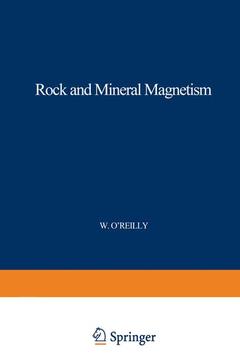Rock and Mineral Magnetism, Softcover reprint of the original 1st ed. 1984
Langue : Anglais
Auteur : O'Reilly W.

The past two decades have witnessed a revolution in the earth sciences. The quantitative, instrument-based measurements and physical models of. geophysics, together with advances in technology, have radically transformed the way in which the Earth, and especially its crust, is described. The study of the magnetism of the rocks of the Earth's crust has played a major part in this transformation. Rocks, or more specifically their constituent magnetic minerals, can be regarded as a measuring instrument provided by nature, which can be employed in the service of the earth sciences. Thus magnetic minerals are a recording magnetometer; a goniometer or protractor, recording the directions of flows, fields and forces; a clock; a recording thermometer; a position recorder; astrain gauge; an instrument for geo logical surveying; a tracer in climatology and hydrology; a tool in petrology. No instrument is linear, or free from noise and systematic errors, and the performance of nature's instrument must be assessed and certified. This has been the task of the research worker in rock and mineral magnetism.
1 Introduction to the magnetism of rocks.- 1.1 Rocks as magnetic information stores.- 1.2 The recorded information.- 1.3 Rock and mineral magnetism.- 1.4 Magnetism—some preliminaries.- 2 Magnetic minerals in rocks.- 2.1 The magnetic mineral systems.- 2.2 The magnetic mineralogy of igneous rocks.- 2.3 The magnetic mineralogy of sediments.- 2.4 The magnetic mineralogy of extra-terrestrial materials.- 2.5 Summary.- Selected bibliography.- 3 The atomic basis of magnetism.- 3.1 The electron spin; the transition elements.- 3.2 Exchange.- 3.3 Curie temperatures of spinel oxides.- 3.4 Magnetocrystalline anisotropy.- 3.5 Induced anisotropy.- 3.6 Categories of magnetic behaviour.- 3.7 Summary.- Selected bibliography.- 4 The magnetization process.- 4.1 The demagnetizing field—shape anisotropy.- 4.2 Domains and domain walls.- 4.3 The magnetization process.- 4.4 The time-dependence of magnetization—equilibrium and thermal agitation.- 4.5 Summary.- Selected bibliography.- 5 Thermoremanent magnetization.- 5.1 The mechanism—definitions of blocking temperature.- 5.2 TRM models.- 5.3 Thermal demagnetization—partial TRM.- 5.4 Self-reversed TRM.- 5.5 Summary.- Selected bibliography.- 6 Other remanence-inducing mechanisms.- 6.1 Mechanisms in nature.- 6.2 Mechanisms in the laboratory.- 6.3 Summary.- Selected bibliography.- 7 Magnetic properties of titanomagnetites and titanomaghemites.- 7.1 The titanomagnetites.- 7.2 The titanomaghemites.- 7.3 Multiphase products of the oxidation of titanomagnetite.- 7.4 Summary.- 8 Magnetic properties of other mineral systems.- 8.1 Haematite.- 8.2 The haematite-ilmenite solid solution.- 8.3 The pyrrhotites.- 8.4 Goethite.- 8.5 Iron.- 8.6 Alteration products of non-magnetic minerals.- 8.7 Summary.- 9 Applications of rock and mineral magnetism.- 9.1Introduction.- 9.2 Physical models—the acquisition and removal of weak field remanences.- 9.3 Determination of the composition, concentration and microstructure of the magnetic mineral fraction in a rock (or other material).- 9.4 Connections in planetary physics—the magnetization of planetary crusts.- 9.5 Summary.
Date de parution : 04-2012
Ouvrage de 220 p.
15.2x22.9 cm
Thème de Rock and Mineral Magnetism :
Mots-clés :
Pet; climatology; earth; evolution; fields; geophysics; hydrology; hysteresis; magnetism; magnetization; mineral; noise; physics; tracer; tractor
© 2024 LAVOISIER S.A.S.
